Striped bass are tough creatures, but the strain put on a fish while being caught is intense.
Imagine you just ran a marathon, and then suddenly someone covered your mouth and you couldn't breathe. That might be what it's like for a striper.
It's no surprise that research has shown that keeping fish in the water as much as possible during the unhooking process can go a long way. Removing the fish from the water can really decrease the odds of its survival.
But trying to keep the striper in the water is just part of the puzzle. There are also plenty of situations in which keeping the bass in the water is not possible, or even dangerous.
That's why I feel it's really important to do everything in our power to catch and release stripers in the least harmful way possible - especially if fishing at the Cape Cod Canal.
The reason I mention the canal is that it's a hot spot for poor catch and release practices. It seems that a lot of people who fished the canal in the past decade (especially during the incredibly productive 2017 season) did not know how to properly release a striped bass. Poor catch and release tactics resulted in dozens of dead fish floating in the canal's swift current.
By following the six tips outlined below, you will help ensure that the striper you just caught swims away alive and healthy.
1) Reduce Angling Duration
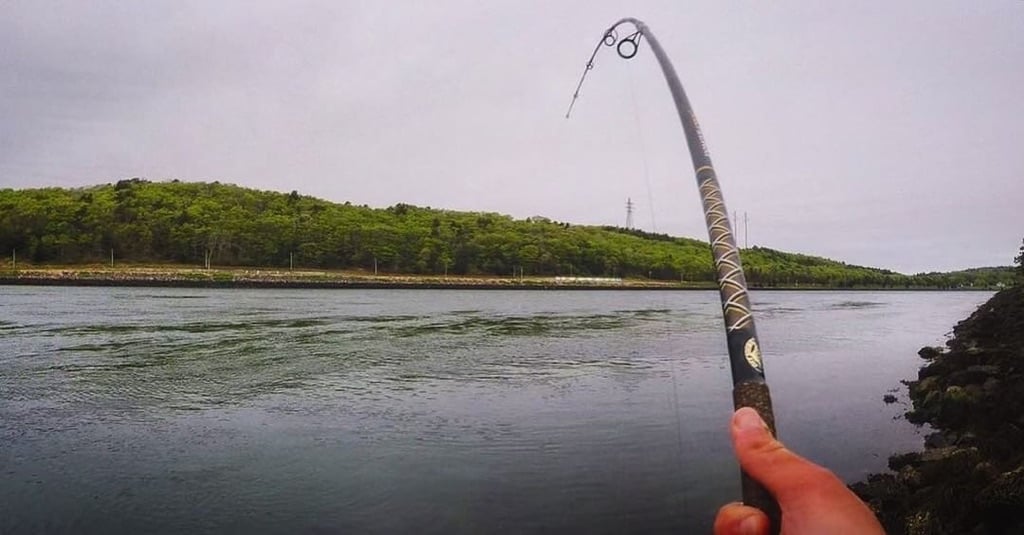
By landing a fish quickly and without playing it to exhaustion, you can dramatically reduce stress the fish incurs.
This can be achieved by ensuring you are using a 10-11ft rod rated for at least 5 ounces, paired with a reel that can hold at least 300 yards of 50lb braid.
Tighten your drag and get the bass in quick.
2) Hold Stripers Over The Water
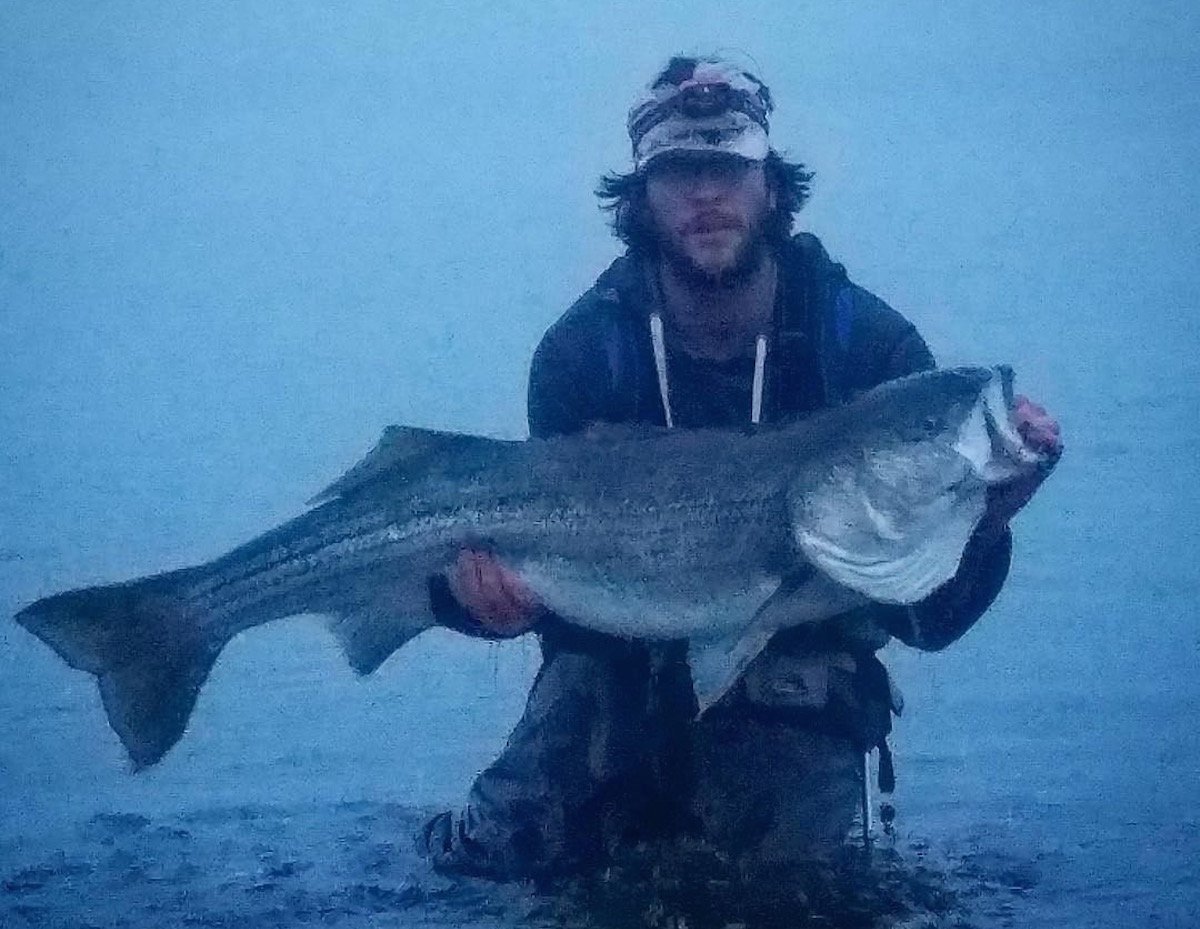
In the photo above, MFCC Derby winner Dane Wetmore did a good job holding the striper over the water (and not over land).
Stripers are slippery creatures and can easily be dropped.
So when holding a fish, keep it in or slightly above the water - not over the rocks.
That way if dropped, it falls back into the water unharmed.
3) Consider Barbless Hooks
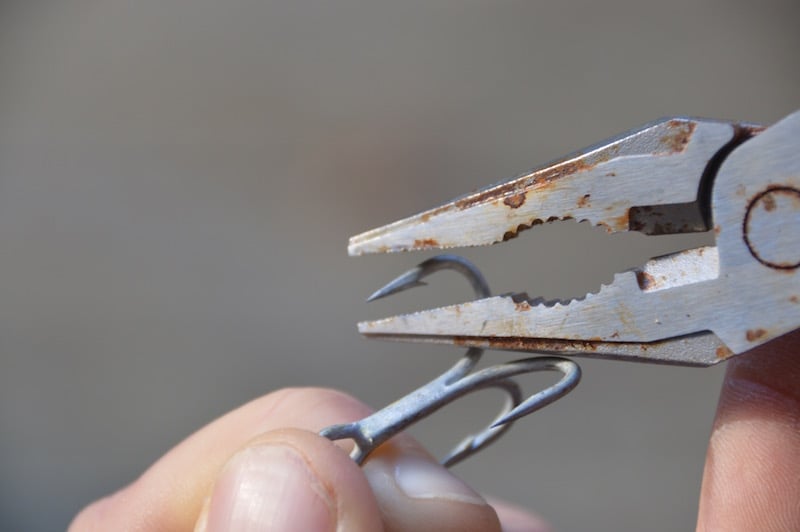
An easy way to increase the chances of a striped bass surviving after you catch it, is to crimp the barbs on hooks.
Not only do barbless hooks cause less damage to a stripers’s mouth, but they are also much easier and quicker to remove - especially important when one ends up in your ear or finger!
Of course also keep in mind that you will lose more fish when you use hooks that do not have barbs. For me personally, I crush the barbs on my hooks whenever the fishing is "lights out".
In other words, if I'm catching fish left and right, then I'm going to use barbless hooks. If the fishing is super slow and I might only get one or two bites a day, then I will most likely leave the barbs on.
4) Carry Hook Removal Devices
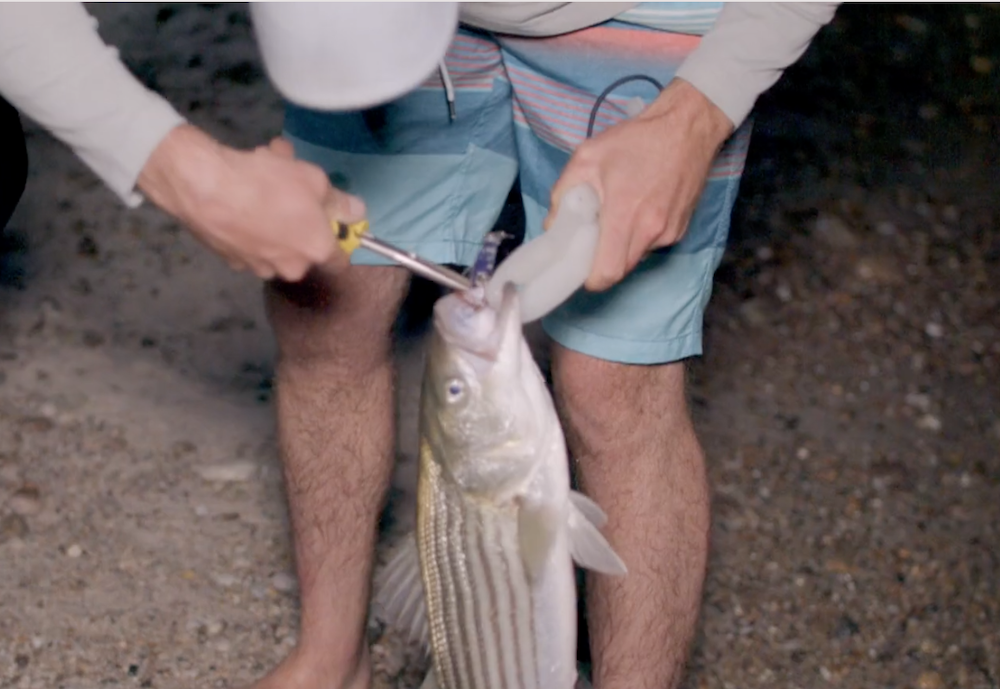
One thing I recommend all anglers always carry on them are needle nose pliers. Wearing your pliers on your hip, or having them somewhere else that is easily accessible, will make unhooking stripers much quicker and easier.
If you do not have a lot of experience handling striped bass, then I recommend using a fish grip, especially when using treble hooks. A fish grip tool can be very helpful for quick and safe hook removal.
I personally don't use a fish grip because I'm very comfortable and accustomed to handling stripers. Plus the tool can exert a lot of unnecessary pressure on a fish's jaw.
5) Photograph Wet Stripers & Hold Horizontally
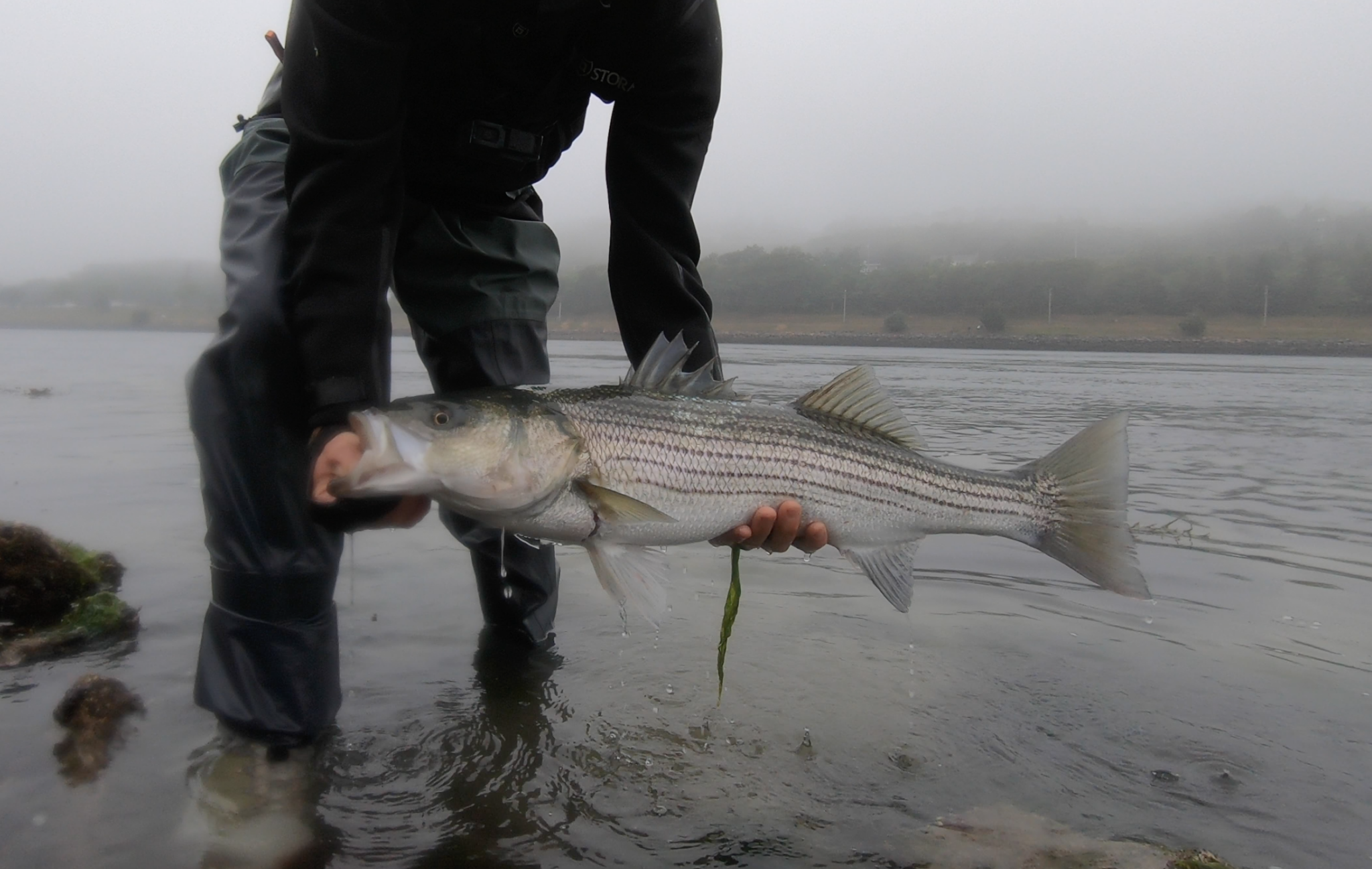
Poor fish photography practices have been an area of concern ever since the rise of social media. This is particularly noticeable at the Cape Cod Canal, where anglers often catch huge photo-worthy stripers.
It is certainly best to photograph wet stripers, and to hold the striper over the water. This way if you drop the fish it will land in the water, and not on dry sharp rocks, which is especially important at the canal.
If a fish is momentarily taken out of the water, keep it as close to the water as possible and fully submerge it between pictures to give the fish a quick breather.
Ideally, let the photographer call the shots – 1, 2, 3...raise the fish....and click.
Hold the fish horizontally and support the belly. Do not hold the fish vertically by the gills or by the jaw, as this can exert a lot of pressure on a big heavy fish.
6) Carefully Revive Stripers
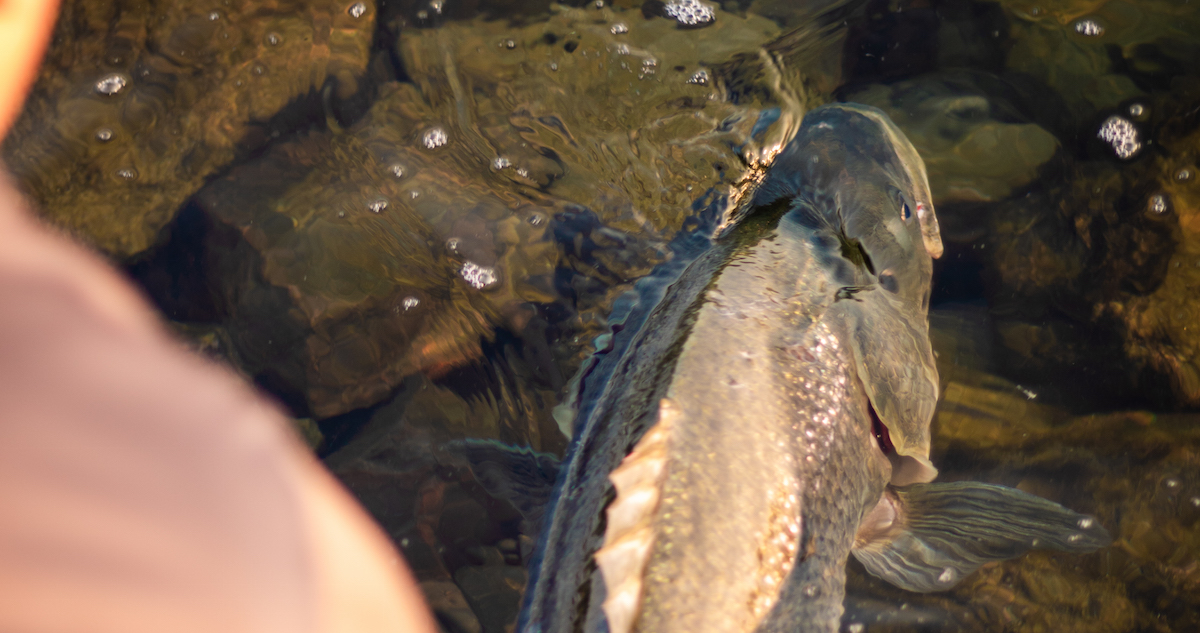
Photo by @andrewburkepv
If a striper can not swim away on its own it may need reviving.
This can be done by submerging the fish and holding its head facing up-current so that the water runs in the mouth and through the gills.
In still water situations, move the fish in a figure 8 pattern to simulate this effect. The striper will bite down on your thumb when it's ready to swim away.
Bonus Video | Properly Releasing Striped Bass
As a collective group of anglers we probably catch and release tens of thousands of stripers each and every season here on Cape Cod. These fish encounter a lot of hooks throughout their lifetime and many fish are caught and released several times.
So without a doubt I think we can all understand how important it is to do the best job possible when catching and releasing striped bass (and other species).
A few years ago I published a video here on MFCC about properly releasing striped bass. In the video we go over a few of the tips mentioned above, but with live fishing footage so you can see it in practice.
Click below to watch!
In the video I focus on three important keys to successfully releasing a striped bass in good condition, including:
- 1Keeping the fish in the water (when safe and possible) and minimizing handling. There are instances like when fishing in big surf or along the beaches of the Outer Cape where keeping the fish in the water can be dangerous, but when possible it's definitely good practice.
- 2If you want a photo, then remove the fish from the water for just a few seconds, and hold the fish horizontally.
- 3Consider crushing the barbs on your hooks, especially when catching schoolies. I'll be the first to admit that I don't always crush barbs, especially when targeting big fish, or when guiding, because you will lose more fish with crushed barbs. However I do crush barbs when I encounter blitzes and situations when myself or clients are catching fish on every cast. I also crush barbs if there's only schoolies around there's no chance of catching a trophy.
In Conclusion
By always looking to improve our fish handling practices, we can help ensure we do as little damage as possible and improve the fish's chances of survival.
I feel this is especially important for striped bass, because they are targeted so extensively by so many anglers along our coastlines.
What catch and release tips did I miss? Do you have any recommendations of your own? I'd love to hear them, so please let me know by leaving a comment below.
Tight lines!



My comments regard barbless hooks and single hooks. BARBLESS HOOKS…For many years, Washington State salmon anglers were required to use barbless hooks. As a former fishing guide, and dental surgeon, it was easy to see that this law provided a safety factor for both fish and angler alike.
For fish, it reduces injury and mortality. For the angler, it exponentially reduces a costly trip to the emergency room, A barbless hook basically imitates a suture needle that easily passes through human, and animal, tissue without restriction. SINGLE HOOKS…For over half of my 86 years, I have been a fishing lure designer of different designs.
However, I am passionate about fishing with metal jigs because of their effectiveness and versatility. I only use a single siwash-style hook on the tail end of my jig vs a treble, or a nose-attached assist hook. A siwash-style hook is featured with a wide bend and a deep throat. The wide bend is for hooking more fish and the deep throat holds on to the fish better after it is hooked. a) The treble hook lacks these two critical designs and will also snag easier when bounced over rough bottom. b) Nose-assist
hooks are not versatile compared to a properly designed metal jig with a single tail hook.
Presently on the market are three different metal jigs that I have designed. The first being the Crippled Herring, now marketed by Rapala. Its package states that it can be cast, jigged or trolled. The single tail hook acts like a rudder that gives the jig an extra darting and vibrating action when retrieving or trolling. This gives the metal jig the ability to out-fish conventional trolling lures.
Conversely, the nose-assist hook is a poor cast or troll lure and its singular use is that of a vertically jigged lure (aka “slow pitched”). During the early development of the Crippled Herring, it was intensively tested for several years in saltwater for the best hook style and where it could be placed on the lure. It was in Alaska where I found the hard way as to where the hook should be placed. A 7/0 was placed on both the nose and tail of a 6 1/2 oz Crippled Herring for halibut jigging. The first halibut hooked on that jig was about 70 lbs.
After subduing it, one of the other skippers heaved it into the boat. The fish was hooked on the tail hook. As I reached to remove the tail hook, the halibut suddenly jerked back to life and completely impaled the nose hook into the palm of my left hand. Since no medical facilities were available in our remote camp, I cut the hook out of my hand and suffered no complications. It was on that day that determined only a tail, not nose, hook would be equipped on all of my jigs.
The final test scores showed that over a two-year testing period, over 95% of all fish types were hooked on the tail hook when vertical jigging. When trolling, 100% were hooked on the tail hook.
Epic comment Pete! Thank you so much for taking the time to write all that out. I really appreciate it.
Ryan – I’m really happy you are emphasizing good catch and release practices. Perhaps you could do a video on replacing treble hooks with single hooks for a variety of lure classes. I am currently struggling with some of my poppers, stick baits, and spoons to find appropriate single hooks that don’t change the action of the lure.
Scott
That would be a great topic for a video Scott. I will certainly keep that in mind. Thank you for the idea!
In the meantime, we have two threads inside our forum about this which you might be interested in:
– Replacing trebles with in-line hooks
– Swapping trebles for in-line single hooks – sizes?
Tight lines and good luck out there this week! ?
I generally don’t use treble hooks. Lures with a single hook like bucktail jigs and soft plastics are effective and do less damage to the fish. I also try not remove the fish from the water before releasing.
Great trips Jim. Thank you for the comment! ?
Let a 45 inch go today in the canal. Had to revive. Seen so many not make it because anglers not following your tips. Great job need to get this out to the masses especially fishing canal. TR
Nice job with that 45 incher ? As you mention, it would be terrific if these tips circulated to the masses. Thank you for the comment Tom!
Thanks Ryan, good info! I watched a guy yesterday scoop and chuck each fish onto the sandbar like he was afraid of the fish. I felt like it was a teachable moment but didn’t want him to take it the wrong way so I didn’t say anything. If your afraid of the fish your catching maybe find a new hobby? Any suggestions when landing fish in waste deep water, I know I struggle trying to keep my reel dry while releasing a fish. I already practice the things above but maybe I am missing something.
Hey Giles! Thanks for commenting!
When landing a fish in waist deep water, I try to grab the leader and keep the fish an arm’s length away from me, while I tuck my rod and reel under my right arm pit. It’s a bit of a balancing act but it’s the best solution I’ve come up with. A fish grip can help a lot too, especially if you are using treble hooks.
Thank you for this information, Ryan.
I live in the Northwest, and do most of my fishing for salmon and steelhead. The wild strains of these fish are endangered, so there are a lot of regulations to protect them. Barbless hooks are the rule. Though at times you can keep wild fish, often you can only keep fin-clipped hatchery fish, and you have to let wild ones go.
All of your tips are great. In Oregon, when you see that the fish you’re landing is not fin-clipped, meaning it’s a wild fish, you’re not even supposed to take the fish out of the water while you remove the hook to release it. At worst, you should remove the fish from the water as little as possible. You can help a stunned or exhausted fish by grasping it by the tail and gently waving it back and forth in the water to help it get a little more water turbulence around it’s gills.
Like wild salmon and steelhead, stripers are beautiful fish. I like to think that I owe them respect for the challenge and pleasure they give me in catching them, and I want them to be around for a long time for others to enjoy.
Thanks again, Ryan.
Very well said Rob. Thank you for taking the time to write such a great comment. ??
Very well said !
Thanks for reading Naran
Don’t take them out of the water, unless you intend to keep them. If removed from the water for a photo, support the stomach.
Good tip Jeff ??
Good advice for freshwater as well. Most of these tips should be observed when fishing catch and release for any species.
Absolutely. Thanks for reading Art.
Great reminders and for some new and important info, if we don’t work to preserve the species our kids won’t have the opportunity to enjoy fishing
Very true. Thanks for commenting and reading Bob.
Great info and comments – Thanks!
No prob! Thanks for reading ??
Some tips we all need to follow and pass along. So many fisherman don’t know how to care for bass and preserve this precious resource.
It’s definitely surprising how many folks don’t know how to revive and release a fish. Hopefully this post will help a bit. Thanks for reading Ron!
Really important info and a wake up call for striper fishermen
Very true. Thank you for reading and commenting Art ✌?
Great info Ryan and well timed with all the fishing pressure at the Canal. I have always held the fish by the lip as well when reviving them prior to release. This is a great way when doing so from a boat or beach as you can completely submerge the fish as you are swishing them back and forth. I have recently discovered that When releasing from the edge of the Canal I prefer holding the fish just in front of the tail fin. This way the fish’s head and gills are in the deeper water and when the fish is ready you can just let them go and they are facing the right way to swim off. They will let you know they are ready with a big swish of their tail.
The danger with this method is if the fish is not able to stay upright or ready to swim by themselves. Then you may release a fish from your grasp that turns over and floats away. Not good!!! Also you have to make sure that you have a secure hold on the fish until you are sure they are ready. I fish while wearing gloves which makes them less slippery.
Great tips Dex. Thank you!
You hit the nail on the head.
I watch, way to many people in the ditch, crank em in, and just huck them back. All so they can possibly hook up again.
Just takes an extra minute.
Well said bro.
Very true Eddie. It really does just take a few extra minutes. We owe it to the fish to do everything we can to ensure they swim away in reasonable shape.
Thanks for commenting and tight lines out there!
Really good info Ryan.
Thanks much
No problem Paul. Thank you for reading.